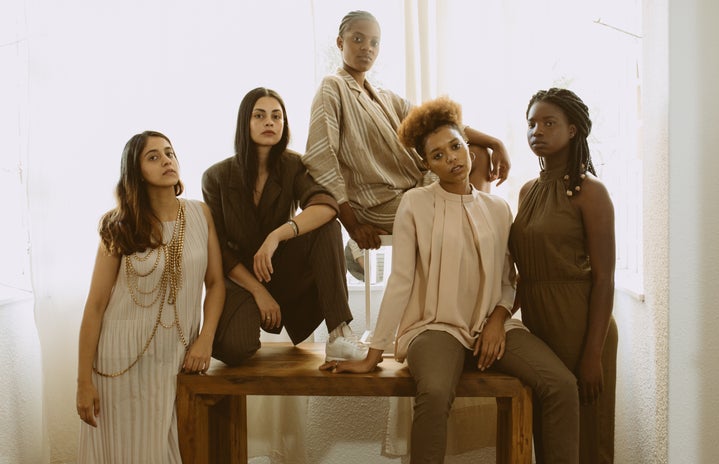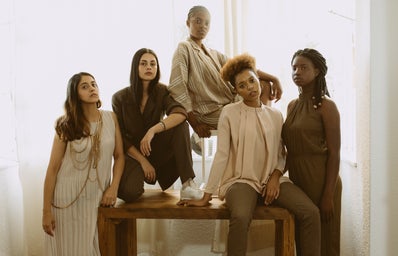The Black impact is all around us in fashion. Ripped jeans, Jordan’s, hoop earrings, bucket hats, logomania, scripted font names or words on necklaces or in earrings, oversized clothing – you name it, a Black person likely created, popularized, or wore that trend before it was a trend.
But it isn’t so simple as a Black person making or wearing the trend and then it becomes fashionable for the mainstream audience. Oftentimes, Black fashion is ridiculed and looked down upon for being “flashy,” “ghetto,” or “unprofessional” before being popularized and sold for profit, often by and for a white audience.
This is a common problem Black people face; it is also seen with dreadlocks. When a white person wears their version of dreadlocks, which never look as good as dreadlocks on Black hair, they are still allowed to be a professional, yet for years when a Black person wore their hair in dreadlocks, it was unprofessional. With the added factor that Black dreadlocks tend to look nicer than white ones, it leaves one clear reason for this difference in treatment: race.
And this isn’t just about hair, fashion or jobs: this same phenomenon just happened in the 2022 Winter Olympics with the comparison of Sha’Carri Richardson to Kamila Valieva.
I wonder how and why an industry that steals so much from a community doesn’t want to be seen worn by that community. The truth is that the fashion industry would be nothing without black communities inspiring, promoting, designing, and buying their designs. You’d think that the community that most directly benefits your industry would be so heavily represented and compensated for their work in your growth, but this tends not to be the case.
To mitigate the persistent belief that fashion is only designed by and for French ladies who can afford enough Chanel for everyday wear, this is the Black impact on fashion.
DESIGNERS:
Dapper Dan: Dapper Dan, also known as Daniel Day, is known as the “king of knock-offs” and popularized and modernized what we know today as logomania. He single handedly created a fashion movement that comes and goes in trends but has become a staple over the years. Logomania is defined as a trend whereby obvious branding is strewn all over one’s clothes. Rather than a brand name hidden away in a shirt on a tag, a fashion house’s logo was now worn to be seen. The LV all over Louis Vouitton’s overpriced canvas bags is logomania, Billie Eilish’s sweat suits are logomania, it is all around us.
Telfar: Telfar is a newer brand of bags whose mantra is “Not for you – for everyone.” They are known for their solid-colored tote bags that have a 3-D “e” and “T” combined to make their logo. Coveted for their popularity and quick sell-out times, these bags don’t need to be crazy expensive to feel nice, look nice, and have a name.
Rihanna: We all know and love Rihanna, and that includes her Savage x Fenty lingerie and clothing designs. Rihanna is a modern pioneer of the lingerie industry, a place that Victoria’s Secret and Pink left to die after the early 2000s. Known for being impossibly sexy, affordable, and size-inclusive, Rihanna made her mark on the fashion industry despite designing more unseen items.
Christopher John Rogers: CSJ’s designs are known for being fluffy, colorful and statements. He does not shy away from a bit of extra glitter, tulle, or texture. I love his designs for being breathtaking without ever being uncomfortably overwhelming. He often sends his models down the runway with shaped afros, protective styles and other underrepresented Black hairstyles.
MODELS:
Tyra Banks: Tyra hardly fits into this category as just a model. Google says that she is an “American TV personality” and despite all her personality coming across the screen, I think we all know she’s more than just that. She began her career as a model and is the first Black woman on the covers of both GQ and the Sports Illustrated swimsuit issue. After this, she started moving into film before creating what I got to know her from, “America’s Next Top Model.” Tyra is in her own category of influential in the fashion industry.
Naomi Campbell: Named one of the five original supermodels (Cindy Crawford, Christy Turlington, Linda Evangelista, Naomi Campbell, and Tatjana Patitz), Naomi created a category for how magnificent she is. She’s been modeling since age 15 and was the first Black model to be on the cover of TIME magazine, as well as French and Russian Vogue.
Winnie Harlow: Winnie is a model who has vitiligo, and has become a public spokesperson for the condition. She was discovered by previously mentioned Tyra Banks on ANTM. She now has modeled for many brands and is currently a brand representative for Desigual. She has also closed London Fashion Week, modeled for i-D and Dazed.
JOURNALISTS:
Andre Leon Talley: In terms of memorable fashion journalists in general, there is only one: Andre Leon Talley. His tragic recent passing has led many to commemorate his work and honor his impact on the fashion industry. He was the Vogue editor that made Vogue, Vogue. Friends with many designers from fashion houses, he was known for being very detail-oriented and having an infectious joy about fashion. He was also seen in SATC The Movie in the Vogue photo shoot wedding dress scene.
Overall, Black designers, models, journalists, and even buyers have shaped the way we see and think about fashion today. Without them, we would not have the trends, thoughts, and philosophies about fashion that we do today– the impact is beyond comprehension.


